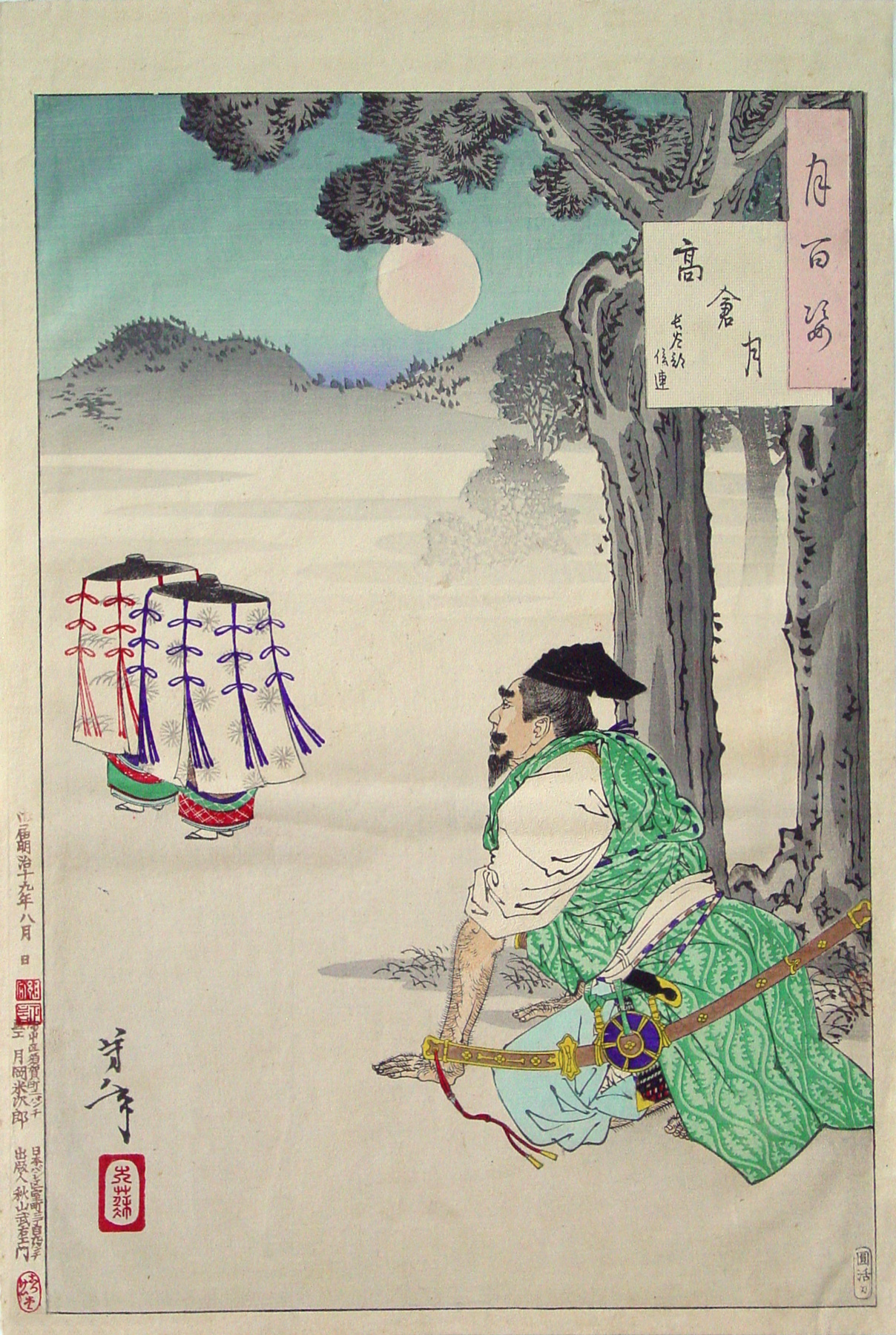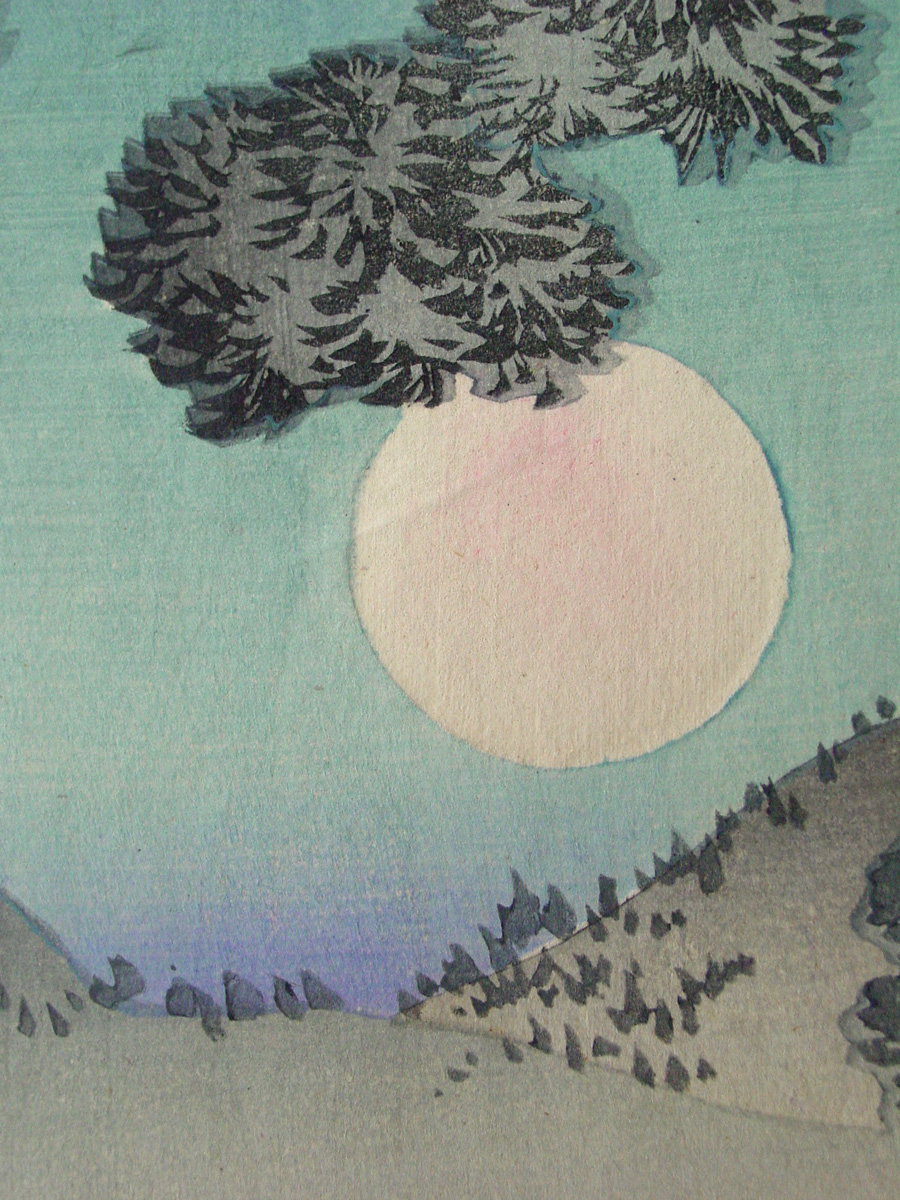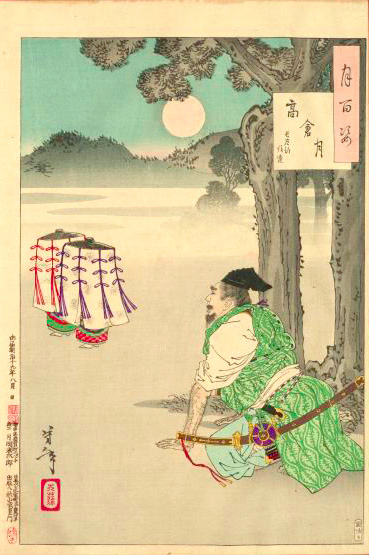About This Print
Source: Museum of International Folk Art http://www.internationalfolkart.org/exhibitions/past/moonweb/section2/062.htm
This print is from the album issued by publisher Akiyama Buemon shortly after Yoshitoshi's death and retains its original album backing.
The Story Depicted in the Print as Told by John Stevenson
Source: Yoshitoshi's One Hundred Aspects of the Moon, John Stevenson, published by Hotei Publishing, Netherlands 2001
36.Takakura moon – Hasebe Nobutsura
Takakura no tsuki – Hasebe Nobutsura
The scene is set in 1180, when the Taira family was at the height of its power. The court was dominated by Taira no Kiyomori, who had just installed his infant grandson as emperor with himself as regent. Yorimasa, a Minamoto nobleman, was infuriated at this usurpation. He began to organize resistance against Kiyomori, declaring his support for Prince Mochihito, the second son of Emperor Go-Shirakawa, who had far more valid claims to be emperor then did Kiyomori’s grandson.
One the fifteenth evening of the fifth month, the prince was quietly viewing the full moon at the Takakura mansion outside Kyoto. The peace was broken by Munenobu, Yorimasa’s foster brother, who burst in with a message that Kiyomori had discovered their plans and was sending soldiers to arrest them. One of the prince’s retainers, called Hasebe Nobutsura, quickly arranged for Mochihito to escape dressed as a woman. This was a good disguise, since upper-class ladies wore an all-concealing hat and veil when they traveled. Here we see Nobutsura kneel as he watches the prince and Munenobu disappear into the misty countryside around the mansion. They walk with the quick, short steps of high-born women, the tassels on their veils swaying rhythmically.
Prince Mochihito’s escape was a famous story, known to a Meiji audience through the history Azuma kagami, Mirror of the East, as well as the Heiki monogatari. The design of the print is a straight-forward narrative. The fleeing figures stand out distinctly against the insubstantial ground but are too small and simplified for us to identify with them easily, nor are we given clues with which to gauge the emotions of Nobutsura. The synthetic purple, yellow, and green dyes used for the clothes of the three human figures contrast harshly with the moonlit landscape. This landscape is well drawn, however, with effective shading of the bushes in the middle of the print and mists receding into the background. The trees behind Nobutsura are drawn with loose brushstrokes in the Shijo manner. The moon is printed in very faint pink.
Nobutsura stayed behind to defend the prince’s mansion. He fought fiercely, killing ten enemy soldiers before he was overpowered. Even under torture he refused to disclose where his master had gone. This impressed Kiyomori, who decided to exile him to Hōki province rather than have him killed.
The prince and Yorimasa organized an army but were trapped by overwhelming forces at Uji Bridge. Yorimasa held them off with great gallantry, enabling the prince to escape, then realized his position was hopeless and committed seppuku. Prince Mochihito was pursued and killed. Eventually the pendulum of power swung, and the Taira family was itself destroyed in 1185. Minamoto no Yoritomo became shogun. He recalled Nobutsura, who had started his career as a soldier without rank in the imperial guard, and gave him a large fief. Nobutsura died prosperous and happy in 1217.
About the Series "One Hundred Aspects of the Moon"For details about this series which consists of one hundred prints with the moon as a unifying motif, see the article on this site Yoshitoshi, One Hundred Aspects of the Moon.
Print Details
| IHL Catalog | #333 |
| Title | Takakura Moon - Hasebe Nobutsura (Takakura no tsuki - Hasebe Nobutsura 高倉月 長谷部信連) |
| Series | One Hundred Aspects of the Moon (Tsuki hyaku sugata 月百姿) |
| John Stevens Reference No.* | 36 |
| Artist | Tsukioka Yoshitoshi (1839-1892) |
| Signature | Yoshitoshi 芳年 |
| Seal | Taiso 大蘇 |
| Date | August 1886 (御届明治十九年八月 日) |
| Edition | Likely from the album issued posthumously by the publisher. |
| Publisher | Akiyama Buemon (秋山武右エ門) [Marks: seal 26-132; pub. ref. 005] |
| Carver | Enkatsu tō (円活刀) [full name Noguchi Enkatsu] |
| Impression | excellent |
| Colors | excellent |
| Condition | good - backed with print separating from backing paper resulting in wrinkling of print |
| Genre | ukiyo-e |
| Miscellaneous | |
| Format | oban |
| H x W Paper | 14 1/4 x 9 5/8 in. (36.2 x 24.4 cm) |
| H x W Image | 12 7/8 x 8 7/8 in. (32.7 x 22.5 cm) |
| Collections This Print | New York Public Library Humanities and SocialSciences Library / Spencer Collection 1269840; Yale University Art Gallery 2011.143.1.36; Tokyo Metropolitan Library 加4722-51; The Tsubouchi Memorial Theatre Museum of Waseda University 401-0535; Ritsumeikan University ARC NDL-541-00-052 |
| Reference Literature | * Yoshitoshi’s One Hundred Aspects of the Moon, John Stevenson, Hotei Publishing, Netherlands 200, pl. 36. |




